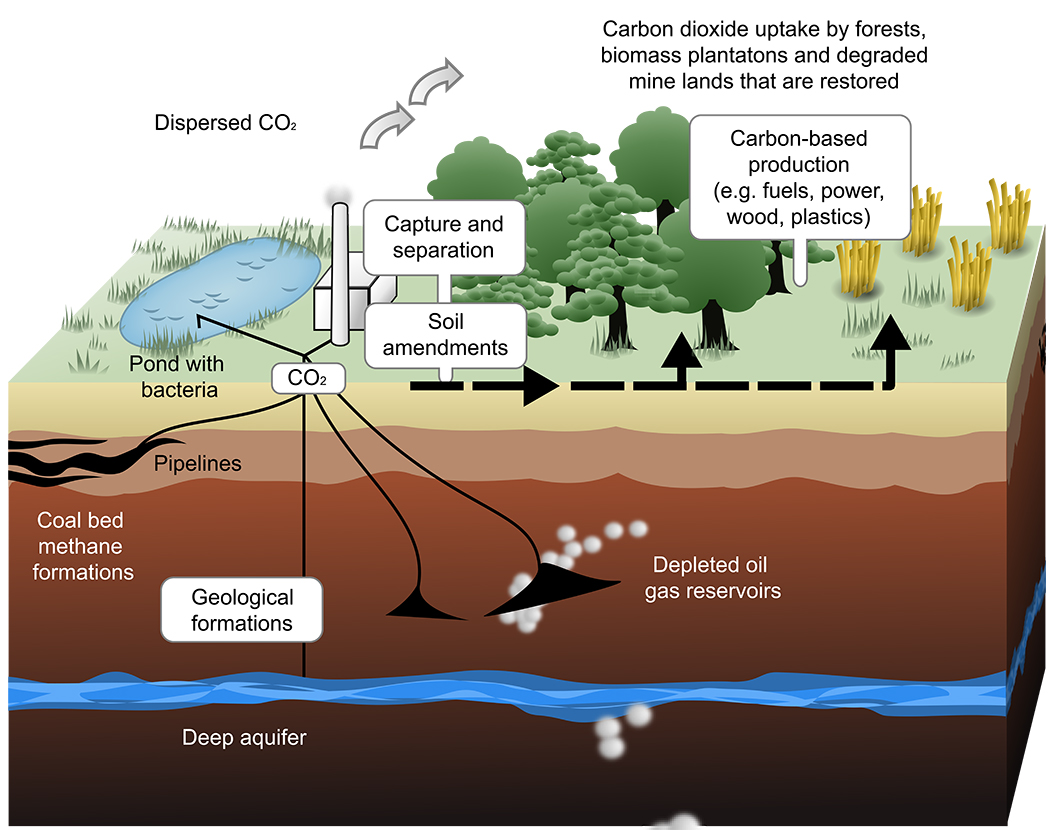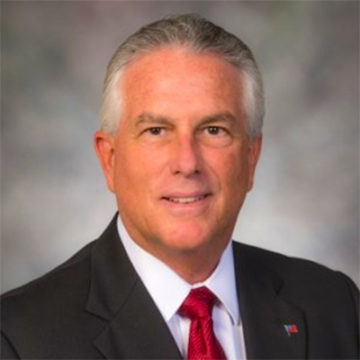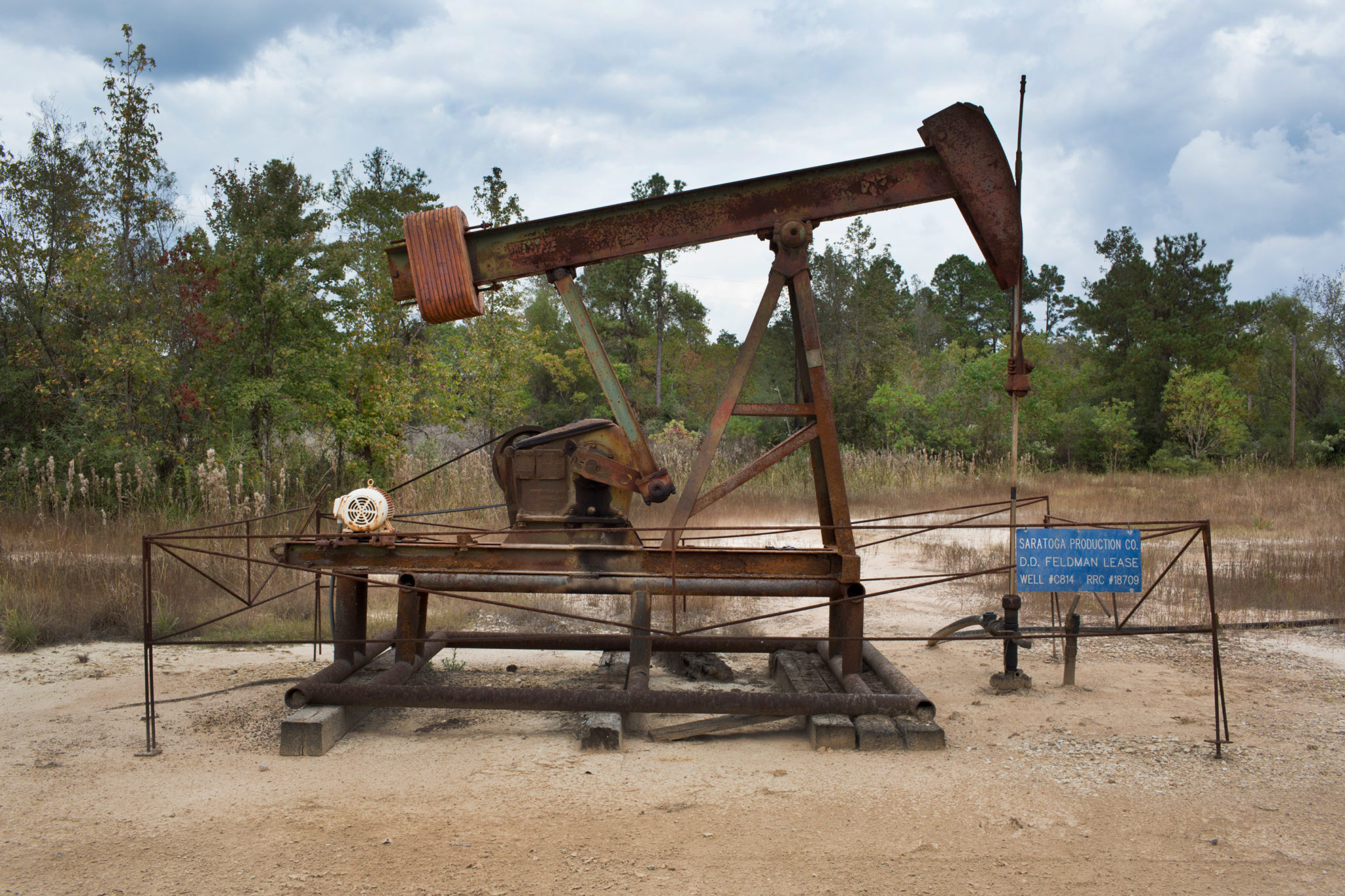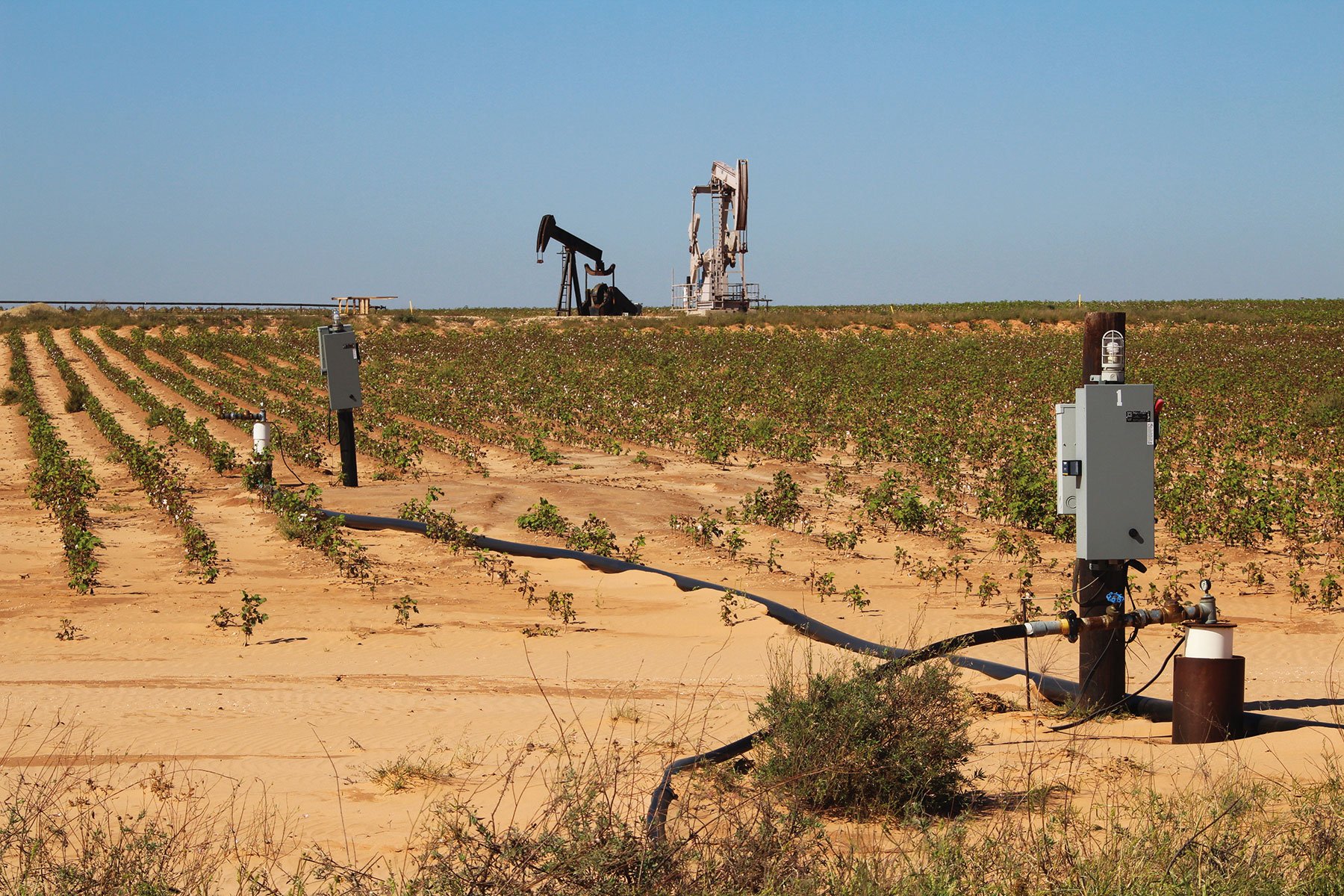
–
by Sammy Feldblum
May 15, 2019
The Farnsworth Unit Oil Field is a small oil patch in North Texas’s Anadarko Basin, just south of where the skinny Oklahoma Panhandle meets its Texas counterpart. Twenty-seven square miles of corn, winter wheat and other feed grains wave beneath retreating geometric rows of wind farms catching the area’s powerful gusts. Texas is the nation’s largest producer of wind power, and these windmills offer one vision of the state’s energy future. Crowded nearby are monuments to another path: Beside the turbines, placid oil derricks pump.
Derricks are a familiar sight in Texas, but these utilize a technology that proponents claim allows for a greener barrel of oil. Through enhanced oil recovery (EOR), the Farnsworth Field uses carbon dioxide emitted and captured at nearby industrial facilities, compressing the gas into a supercritical fluid — a sort of liquid-gas hybrid — piping it onsite and injecting it underground. The flood of compressed CO2 adds pressure to the untapped oil, boosting the field’s productivity, while the carbon dioxide that would otherwise have burned off remains stored underground.
Experts agree that in order to keep global warming below 1.5 degrees Celsius — the threshold established by the Intergovernmental Panel on Climate Change to avoid the most catastrophic effects — we will have to cut and eventually eliminate carbon emissions by shifting from fossil fuels to renewables like wind and solar. But that shift will take time. The IPCC’s latest report, published in October 2018, suggests four approaches to keep warming to less devastating levels. Each stipulates pulling carbon from the atmosphere; most models depend on widespread use of carbon capture and sequestration (CCS) technology. CCS aims to reduce the carbon that fossil fuel combustion and other industrial processes release, scrubbing emissions and storing the carbon geologically before it can escape into the atmosphere. EOR, which uses that carbon to rejuvenate flagging oil fields, is just one form of CCS, albeit one with enormous appeal to extractive industries.

Capturing carbon is a controversial tactic. Its proponents point to the global economy’s still-heavy reliance on fossil fuels, suggesting that reducing the carbon dioxide released will be essential until renewables can take over. Opponents counter that carbon capture technology allows for more burning of fossil fuels, delaying the inevitable transition while padding the pockets of oil and gas companies.
The question is especially important in Texas. In addition to a thriving oil and gas sector, the state is at the vanguard of developing CCS technology, with the nation’s first enhanced oil recovery project and its first commercial carbon-capturing power plant. The Farnsworth Field is one of many Texas projects hoping to help the oil and gas industry become more green. It just may not be green enough.
–
The quickening of the climate crisis has renewed interest in carbon capture, but the technology has been around in various guises for decades. In 2003, George W. Bush’s Department of Energy launched seven Regional Carbon Sequestration Projects across the country to investigate options for storing carbon. Those included saline aquifers — where carbon goes into salty underground lakes and nothing, presumably, comes out — and oil fields, where the carbon could be used to produce more oil.

The focus of those projects shifted under Charles McConnell, a veteran of the oil and gas industry who was assistant secretary of energy at the DOE from 2011 to 2013. He prioritized EOR at the Farnsworth Field — the flagship project of the Southwest Partnership — and at the regional partnerships generally. McConnell is now executive director of the Center for Carbon Management and Energy Sustainability at the University of Houston and emphasizes reuse to reduce the costs of sequestering carbon. Now, he says, the DOE’s emphasis is on carbon capture, use and storage. The “use,” he says, means that companies will actually implement the technology, “because we would get the same impact from CO2 storage but we would have a business purpose to drive it forward.” Perdure Energy, Farnsworth’s operator, buys the carbon that a nearby fertilizer plant and ethanol plant capture; the company can pay for that carbon with the oil that the compressed CO2 helps to produce.
There is an obvious irony to deploying this strategy as a climate intervention: It keeps carbon from the atmosphere by using it to pump carbon-intensive fuels from the ground. “That oil that comes out, some of it turns into carbon,” says Dr. Robert Balch, the principal investigator at the Farnsworth Field. “But you do get a net reduction in CO2.” According to the International Energy Agency, oil fields that use enhanced oil recovery can see a 63-percent reduction in CO2 emissions per barrel of oil produced. And the technology is available already, along with an economic model that makes it viable. Implementing these projects and measuring the effects can allow for carbon storage now, Balch says, while scientists and regulators work toward large-scale storage in saline aquifers.

But Robin Schneider, executive director of the Texas Campaign for the Environment, thinks that a more fundamental energy transition is needed. She stresses that her organization is not flatly opposed to carbon capture in every case. But “the unsustainable economy that mines, manufactures and then wastes so much — the ‘take, make, waste’ economy — that’s more of our general focus when it comes to climate change,” she says. “We don’t think carbon sequestration is necessarily going to work.”
That hesitation is common among environmentalists. In February, Democrats in the U.S. House of Representatives passed a Green New Deal resolution, an ambitious wishlist for sweeping climate action. In a January letter to Congress anticipating the passage of the resolution, 626 groups — including Greenpeace, 350.org and the Texas Campaign for the Environment — said they “vigorously oppose” CCS, calling it a “corporate scheme.” These environmentalists pushed the authors of the Green New Deal to explicitly denounce CCS technology as a climate solution; instead, lawmakers sidestepped the issue.
There is an obvious irony to deploying enhanced oil recovery as a climate intervention: It keeps carbon from the atmosphere by using it to pump carbon-intensive fuels from the ground.
EOR is even more contentious than saline CCS. The method was pioneered in West Texas in 1972. By piping in CO2 from natural gas plants to the south, producers extended the yield of an oil field in Scurry County, where declining pressure had made recovery of its reserves more difficult. The project continues today, using natural CO2 sourced from southwestern Colorado (and thus not offsetting emissions).
Similar projects using anthropogenic, or man-made, carbon have lately proliferated across the state. Outside Houston, the Petra Nova coal-fired power plant processes a portion of its emissions, sending the carbon it captures to the West Ranch oil field in Vanderbilt. It’s the nation’s first commercial CCS power plant and the largest worldwide. A natural gas plant operated by Net Power in La Porte, also near Houston, is experimenting with new technology to capture all of its carbon emissions as part of the combustion process, giving hope that natural gas power generation could someday be carbon-zero. But even then, Net Power must find a way to dispose of the carbon it captures.

Practical doubts about the technology linger. One is the rate at which captured carbon leaks back into the atmosphere. Sequestered carbon would need to remain underground for centuries for CCS to have a meaningful impact, and scientists have not yet been able to determine the leakage rate across substrates. One of the major goals of the Farnsworth Project and the other regional partnerships, Balch says, is understanding “how you can ensure that it stays where you put it.”
Many CCS projects have not even been successful enough to be concerned about leakage, as the history of carbon sequestration remains long on promise and short on results. In one recent case, a coal-and-gas plant in Kemper, Mississippi, promised to capture the carbon its coal operations produced. In 2017, three years behind schedule and $4 billion over budget, the plant announced that it would burn only natural gas, without carbon capture. The scale of the boondoggle is impressive: The Sierra Club calculated that, based on generation capacity, the plant is the most expensive ever built in the U.S.
–
Scott Anderson is the senior policy director at the Texas Environmental Defense Fund and supports EOR. His organization has at times come under fire from other environmentalists for being too cozy with industry interests, a position the nonprofit counters is pragmatic. Anderson figures that more CO2 usage will in fact mean more total greenhouse gasses, as EOR allows oil fields to produce more oil. But reframing the question to consider to the global oil market, he sees a positive impact. “Since there’s really no CO2 EOR operations to speak of outside the U.S. at this juncture, you can say with certainty that whatever oil that the U.S. sequestration-linked oil is displacing is oil that is not trying to save any CO2 at all. So if you take this global perspective … CO2 EOR production is keeping other oil in the ground.”
McConnell, former assistant secretary of the DOE, agrees. “The demand for oil globally will be whatever it is,” he says. “My argument always is that if the next barrel of oil in the marketplace can be produced by a technology that’s simultaneously taking CO2 out of the atmosphere, it’s a far greener barrel of oil than one that would be produced otherwise.”
Saline storage, with no carbon-intensive output, would seem to be the greenest of all. But “saline aquifers have a lot of problems,” says Balch. “The main thing is it’s all money into the ground and nothing back out.” Government subsidies could adjust that equation. In February 2018, the Trump administration greenlighted tax credits for power plants that capture their carbon: $35 per ton if the carbon is reused, $50 if the carbon is sequestered without reuse.

The Natural Resources Defense Council, an environmental nonprofit, worries that even the second-tier credits enable the oil and gas industry. “We don’t support subsidies for fossil fuel production, including subsidies for enhanced oil recovery, that would conflict with the need to reduce our dependence on those fuels,” the council wrote last year. “We will work to ensure that the new tax credits are used as much as possible for CCS projects that bury carbon dioxide in deep geologic formations without producing oil, or put it into materials like cement that lock it up for good.”
The tax credits have their work cut out for them. According to the Global CCS Institute, 10 of the 18 existing commercial operations are based in the U.S and have the capacity to capture about 25 million metric tons of carbon annually. That represents a tiny fraction of the country’s emissions, which the U.S. Energy Information Administration estimated at nearly 5.3 billion metric tons in 2018. Meanwhile, with costs of solar and wind operations dropping precipitously, construction of renewable plants is already often both greener and more economic than new fossil fuel plants.
But fossil fuels, mostly coal and natural gas, account for 65 percent of electric power globally, according to the International Energy Agency. As new coal-fired plants continue to be built across the developing world, capturing carbon emissions remains important to mitigate their effects. Balch, Farnsworth’s principal investigator, is optimistic. “Using technology we have today and these smaller CO2 sources, you could meet the [emission reduction targets in the] Paris Accord with about 1,000 Farnsworth fields,” he says. “And there’s plenty of mature fields out there in the world that would meet that criteria. You need the EOR to get at least to the Paris Accord. And that buys you basically a generation to evolve the rest of our storage technology.” In the meantime, the derricks at Farnsworth are still pumping away.
Top illustration by Maya Lamphier.


